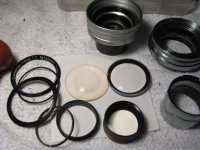Yes it is a 'yellow' Summicron. Who knows - maybe it's still from 1953, but perhaps the serial numbers weren't always used in the years we might think....dunno.
On a totally different tack regarding collapsible Summicrons, years ago (specifically 1993) when I was an undergrad student at Ryerson Polytechnic University in Toronto, I did a three way lens test involving a 1935 Summar, and 1950 Summarit, and a 1956 Summicron (#1348382). The Summarit yielded the highest resolving power at 89.1 l/m at f/16, the Summicron and Summar were both 79.4 l/m at f/5.6. All the lenses seems to exhibit 'coma' at maximum aperture, with the Summarit being the most pronounced. Interestingly, the Summar provided better results wide open than the Summarit! As well, the Summarit actually got sharper from f/5.6 to f/16. Overall, I concluded that the Summicron was the 'winner' of this extensive test (that is, as extensive as I could do it without the ability to do Optical Transfer Function or Edge Spread Width!), and it was the most consistent of the lenses across the board.



